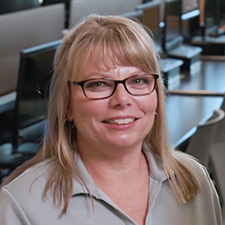
FUSING THE FUTURE

Educators Merge School with Career-Oriented Education

Information Technology instructor, Great Crossing High School
In the heart of Georgetown, Kentucky, Great Crossing High School stands as a beacon of innovative education. Here, the fusion of academics and career-oriented disciplines shapes the future of eager young minds. Leading this educational revolution are Dewayne and Marissa Hancock, a dynamic teaching duo redefining learning and growth in a high school environment.
Dewayne Hancock, a seasoned Information Technology instructor with 16 years of teaching experience, is pivotal in this transformation. His journey in education, now his second career, is fueled by over two decades of rich experience in the IT industry. Alongside his wife, Marissa, Dewayne has been instrumental in establishing a comprehensive print shop within the school, blending design, production, and sales into a real-world learning platform for students.
Marissa Hancock, co-teacher and life partner, brings her blend of expertise and enthusiasm. Her 18 years in education, combined with a decade in retail and distribution management, provide a rich knowledge reservoir.

Information Technology instructor, Great Crossing High School
Together, the Hancocks have transformed the Information Technology program at Scott County Schools. Leveraging Canon’s imagePRESS V700 color production digital press, they have expanded the program’s capabilities. Now, students engage in creating diverse products like district holiday cards, tri-fold brochures, school-branded calendars, literary magazines, and even custom packaging. This practical experience launches students into careers they are passionate about.
How do you approach integrating academics with career-based disciplines, specifically in the IT program, to enhance student readiness for the workforce?
Scott County Schools provides a menu of opportunities for students to choose training among multiple career programs. The Great Crossing High School (Georgetown, Kentucky) Information Technology & Business Services program is one of the leaders in the school district, state, and nation, placing value on the integration of academics and career-based training. Not only are students able to apply multiple core content areas to the live work experiences, they are also able to make connections in a way that prepares workforce readiness.
Project-based learning is a critical component of the approach used by the Information Technology program. Projects can begin as classroom practice, but then evolve into projects that are created for the demands of a local customer. This local customer can be the English or Science teacher down the hall, who needs a visual aid to reinforce standards of learning. The IT students design the visual aid, produce and deliver to the customer for use in all classes.
IT students are highly valued in the school as they serve to produce media for the prom committee or celebrations for student athlete accomplishments. Whether producing an invitation or award, the IT students are leaders. This leadership extends with needs of local businesses, other school districts, national businesses, churches, non-profits, etc. Using industry standard graphic design programs, the projects enable students to continue to expand their skills to a level that often results with industry certification, along with a portfolio of experience for future interviews in the workforce.
What influenced your decision to choose Canon’s imagePRESS V700 color production digital press for the IT program?
A primary reason for choosing Canon’s imagePRESS V700 color production digital press was quality, speed, simplicity, and support. Our school and program strives to expose students to the most updated equipment. Training for the future of our students depends on access to equipment that will be found in the real world. Leasing the imagePRESS V700 has enabled our school training environment to be progressive and provide a unique learning experience for our students.
How has the introduction of the Canon print technology and third-party finishing components expanded the scope and capabilities of your IT program?
Not only are students able to produce high-quality visual media, they are able to do so with purpose for an authentic customer. The empowerment of an engaged student producing real products provides momentum to our classroom that is unmatched with previous instructional methods. This generation of students have passions that are expressed best in an authentic learning environment. We have observed growth and maturity of students at a high level when they realize that practicing their design skills can quickly be tangible in a way like never before.
Our community has no shortage of needs for print material. With that said, our community has no shortage of the desire to support students with their learning by being available with needs for print material, suggestions for expansion, and direct involvement with students. This includes students engaging with their families to produce materials that can be used by their home-based family business. We have also partnered with local franchise owners and partnerships to create materials used in the community. Students are able to work directly with a real customer, which empowers the student and provides them with training in communication that cannot be replicated in the classroom.
How does the internship-level experience in production and finishing technology benefit the students in their future career pursuits?
The small-format print industry is certainly a viable arena in our community. Local businesses are stepping in to work alongside our students as well as give opportunity for internship or (paid) co-op placement. Our local school district values the work produced and provides opportunities for (paid) student (co-op) positions to produce materials needed by the district within our labs.
Some of our students see value in the production equipment and would like to pursue a career in working as a technician or trainer instead of design. All of our students, however, are learning critical evaluation skills to establish competitive price points, inventory management tactic, and quality control concepts. In addition, they are developing both customer service and prospecting skills.
Could you share examples of projects students have worked on and the skills they have developed through these projects?
School and community-branded calendars have been a successful venture to fundraise for our students. Not only can students highlight fellow student athletes in the calendars, but they can also connect with local businesses to showcase their value in our community. For example, one of our students who is highly talented with food photography took pictures of signature dishes from many of our locally owned restaurants. Showcased as “Our Town Eats,” the student was able to produce multiple calendars, which were sold to these businesses, making a profit for each shareholder involved. Our local tourism leads have also been involved with designing next steps for this project. Our school always participates in a holiday card design contest. Not only was the chosen design able to be digitized and produced with the Canon imagePRESS V700 but every student in the program had the opportunity to design and produce their own Christmas card. Once they were able to hold their design to see a final product, they wanted to do even more.


